Our Lady of the Rosary by John Anthony Cybei: a splendid processional machine.
A splendid “machine of the Blessed Virgin Mary.” It is with this expression that an ancient document identifies the marvelous Madonna del Rosario by Giovanni Antonio Cybei (Carrara, 1706 - 1784), a complicated papier-mâché work with a wooden core that has just emerged from a lengthy restoration conducted by experts Cinzia Berti and Michele Paoletti. A restoration that had become necessary because the delicate sculpture was in a poor state of preservation, mainly due to the use that the Madonna del Rosario was put to in the past: it is, in fact, a processional machine, that is, a structure that was carried on the shoulders around the city during religious solemnities. Imagine what it meant to proceed through the crowds with such a delicate object: every slightest bump, every scratch received, every rub involved a bump, a loss of color, in any case a damage or a gap that had to be compensated for. As a result, the work, over the centuries, has been subjected several times to repainting operations that ended up altering its original appearance.
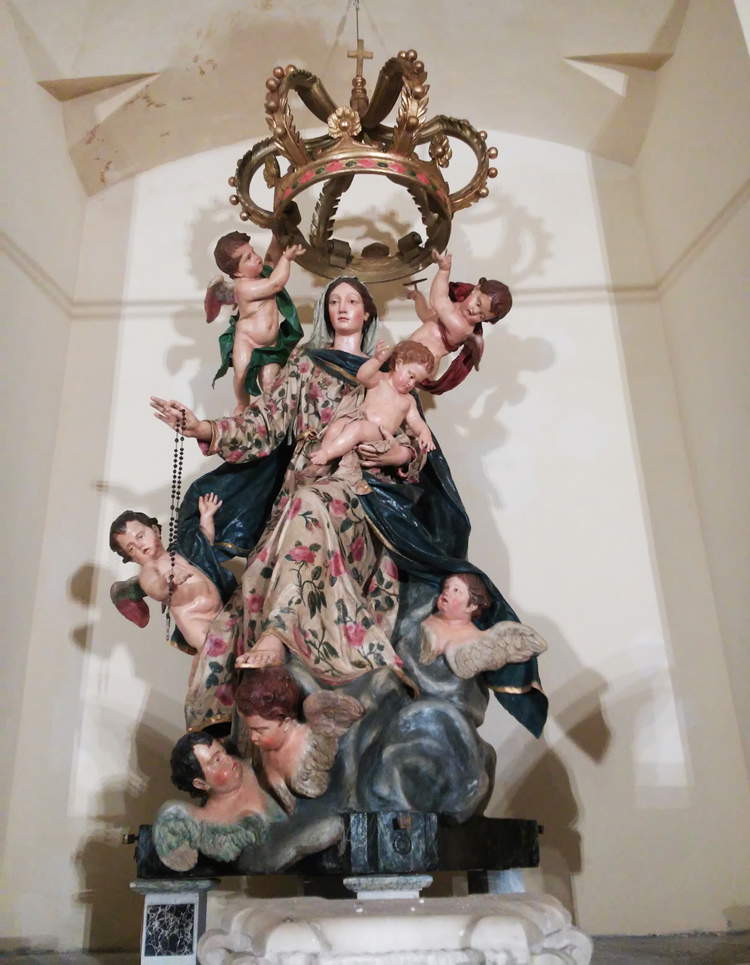 |
| Giovanni Antonio Cybei, Madonna of the Rosary (1739; papier-mâché, wood, canvas; Carrara, Cathedral) |
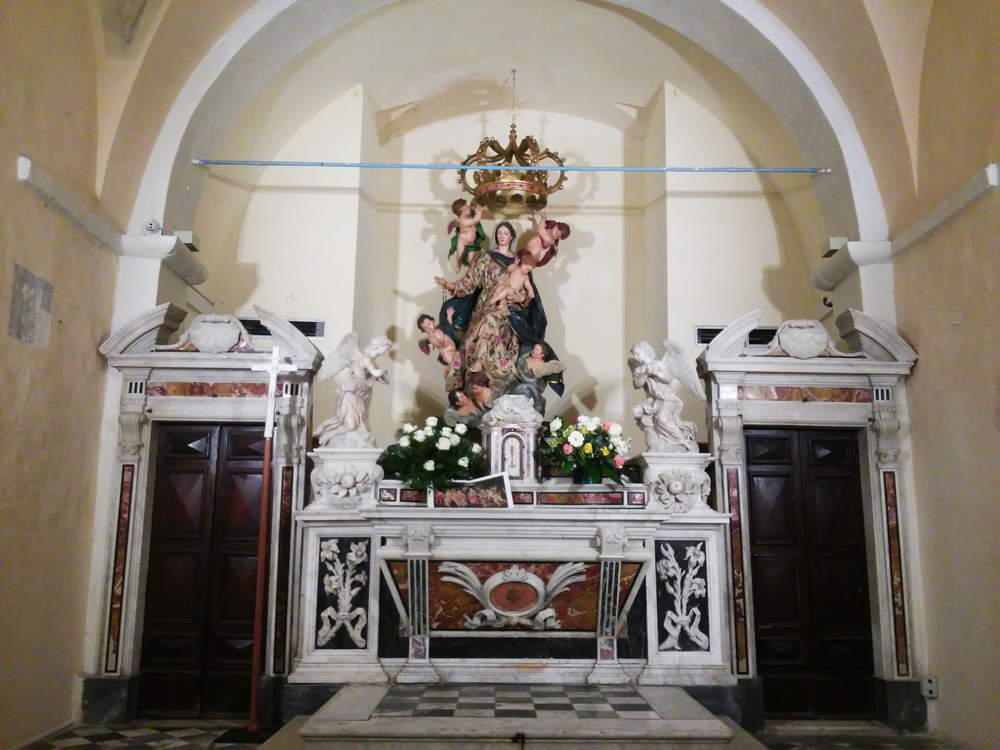 |
| Madonna of the Rosary behind the seventeenth-century altar in the Baptistery of the Cathedral of Carrara |
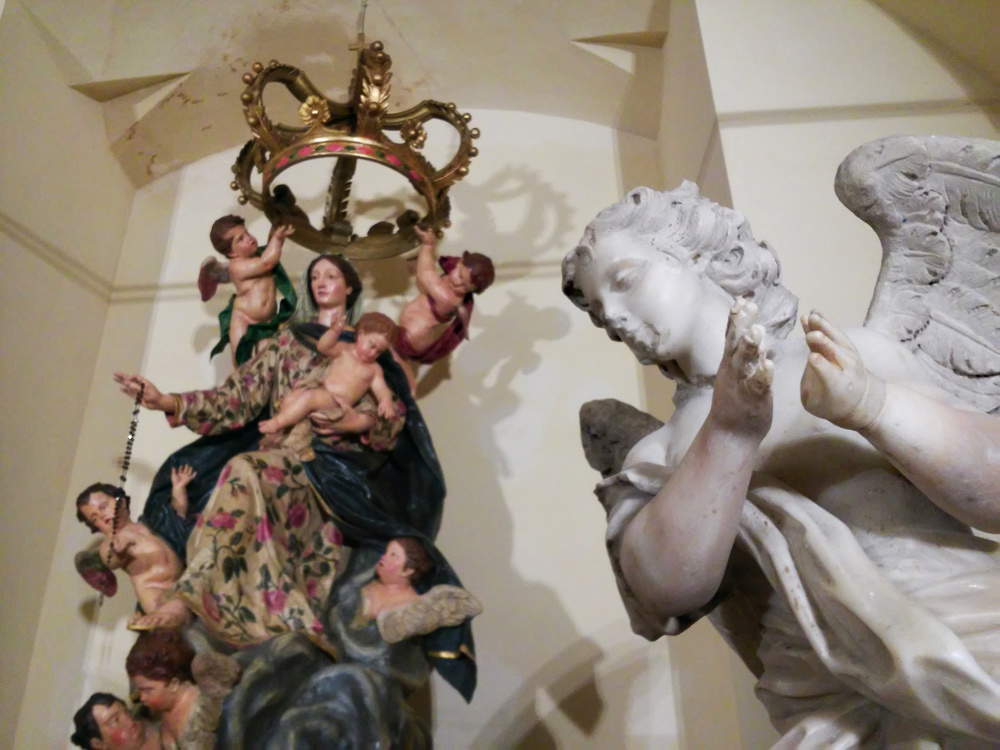 |
| Madonna of the Ros ary with one of the two altar angels. |
The intervention therefore allowed the recovery of the full legibility of the work: it was thus discovered, under a thick layer of color added in later periods, that the Madonna wore a splendid floral robe filled with fresh roses, that the cheeks of cherubs and cherubs were furrowed with slight redness that enhanced their delicacy (the painted decoration, however, is to be attributed to an unknown collaborator of Cybei’s, since the master’s interest in painting dates back only to 1750, as is evident from the documents), and that the Madonna’s gaze is endowed with a depth and expressiveness that, for processional machines, are not such obvious characteristics. A delicate, almost childlike face, pervaded by a slight motion of sadness. A dignified pose, with the left knee advancing so that the graceful foot rests on top of the head of a cherub, who nevertheless does not feel in any way the burden on him: the presence of the Virgin is vivid but very light. Her body, with its noble, slender and elongated forms, is covered not only by the aforementioned robe but also by a blue mantle edged with gold (as per the more classical iconography), which is wide and flutters everywhere, giving the faithful the impression that the apparition is even more solemn. A mantle with which, moreover, putti and cherubs seem to play: the one on the right, for example, hides under the flap that hangs downward and seems almost to want to conceal itself from the eyes of the intrigued Baby Jesus only to suddenly reveal itself as in the most typical of childish games. A baby Jesus responds by moving his hands with some energy: he almost seems to want to escape his mother’s grasp (already very soft in itself) to reach out to his playmate. Above, two little angels, veiled one in green and the other in red (the colors of hope and charity), placed beside the white veil covering Mary’s head (white is the color of the third theological virtue, faith), hold with their fingertips a huge and heavy golden crown topped by a crucifix, to emphasize the kingship of the mother of God (the crown and rosary are not, however, elements that are part of the original work). On the opposite, at the bottom, clouds form the throne on which the Virgin sits.
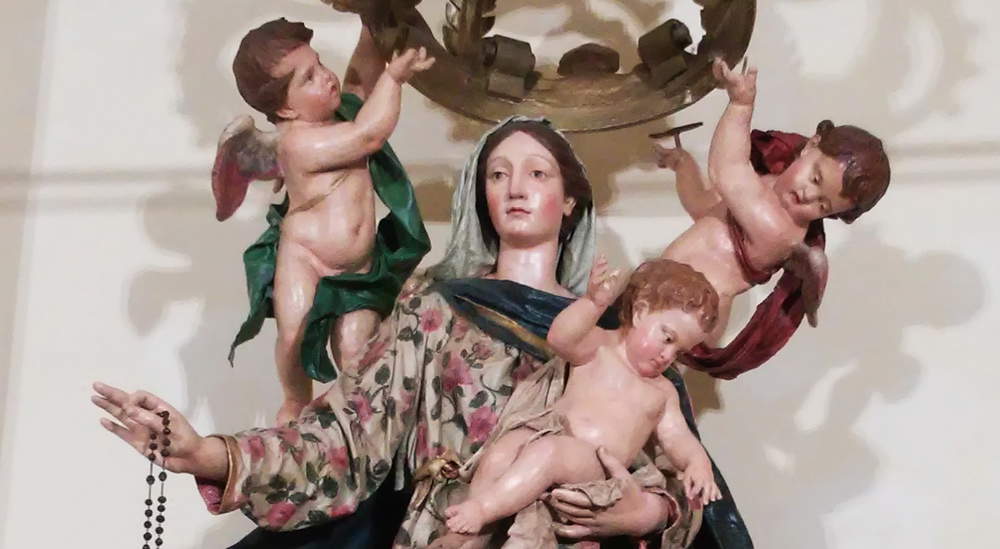 |
| The face of the Madonna and Child |
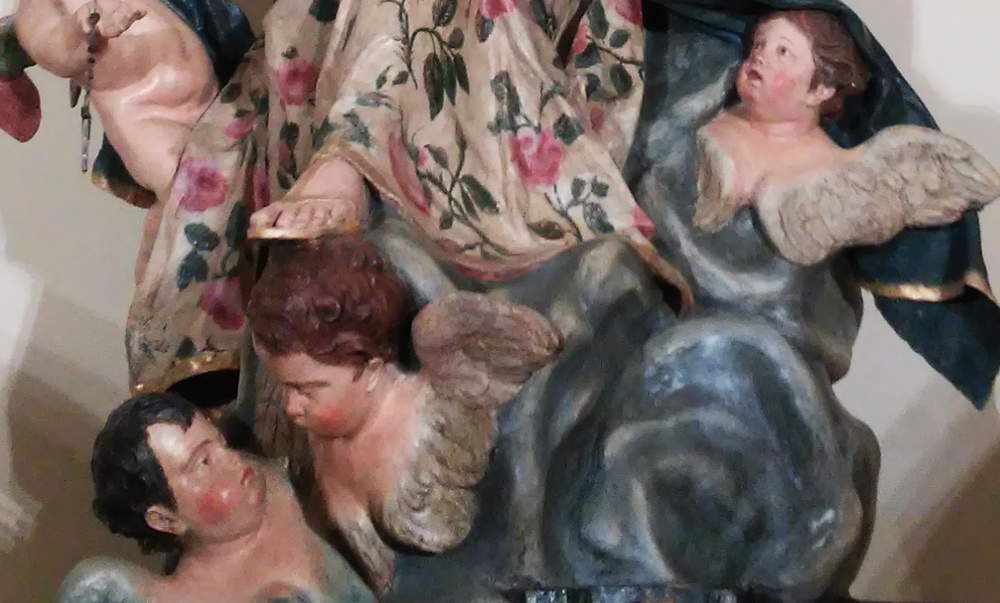 |
| Detail of the cherubim |
Attending a procession featuring this Madonna of the Rosary must have been an experience capable of arousing great wonder. It is a pity that, faced with a work of such value, and what is more, produced by the hand of one of the most important sculptors who worked between Tuscany, Liguria and Emilia in the eighteenth century, the bibliography is as meager as ever: to reconstruct the history of the group has therefore thought of the Carrara art historian Andrea Fusani, who took advantage of the occasion of the restoration to pull the strings of the chronology and execution of the Madonna of the Rosary by Giovanni Antonio Cybei. Fusani’s research also constitutes the first specific study devoted to the work, and we therefore find it very interesting to provide a summary of it in this article.
We start with the assumption that there are no contemporary documents that can give a certain account of the sculpture: the only contemporary note to Cybei tracked down by Fusani is a request, dated 1739, found in the Notarial Archives of Carrara, in which the priors of a town confraternity, the Compagnia del Rosario, requested “erigendi altare amovibile ante machinam ipsius Beata Maria Virginis.” A “machine of the Blessed Virgin Mary” was thus mentioned. Since the movable altar mentioned in the note was to be erected in the cathedral, it is safe to assume that this machine was exposed to the view of the faithful: Fusani also speculates that, given the request to make a movable altar so that the apparatus that housed the Madonna would be complete, the making of the sculpture should not be placed very far from that date. Other discoveries would help reinforce the belief that the “machine” mentioned in the 1739 document is the same one we admire today. In an unpublished letter from August 1783, Cybei recalled that he had executed “some little things” for his city free of charge. The only work that the artist executed for Carrara free of charge of which we have certain information is theAltar of Redemption, which is located in the Cathedral Baptistery: however, since there are no documents certifying payments for the Madonna of the Rosary, there is nothing to prohibit us from thinking that the processional car was also made without the sculptor receiving remuneration. Finally, we know that Cybei between 1738 and 1742 stopped going to the studio of his master, Giovanni Baratta (Carrara, 1670 - 1747), whom he later resumed even when he began to have independent commissions, untied from Baratta’s workshop. However, Cybei had another studio, in what is now Via Finelli (a short distance from the cathedral), located on the second floor of the building: he used it mainly for drawing and modeling. A tradition handed down orally by the Cybei family, which Fusani gives an account of in his contribution, has it that the sculptor made the Madonna of the Rosary in this studio, and then lowered it into the courtyard of the Duomo rectory (which his studio overlooked) through the use of ropes, and it seems that to enable this operation it was also necessary to enlarge a window, because the work could not pass through it.
It is worth mentioning how the name of Cybei, which is never associated with Our Lady of the Rosary in contemporary documents, is evidenced not only by the oral tradition mentioned above but also by some nineteenth-century documents. The first source in which Giovanni Antonio Cybei is mentioned as the author of the Carrara Cathedral processional machine is a document from 1876 in which Canon Pietro Andrei identifies the “sculptor priest Giovanni Antonio Cybei” as the one who “made the image of the Blessed Virgin that is carried in procession as it is also used nowadays.” Interesting then is a quotation in a guide to Carrara compiled by a local nobleman, Count Carlo Lazzoni, who lists the car among Cybei’s final works. A consideration, that according to which the work would belong to the artist’s extreme production, belied by Fusani’s study, not only because of what has been said above, but also because of the stylistic differences that distance the Madonna del Rosario, a work full of vitality, dynamic and animated, from the more calm and classicist works of the 1970s. Many details would then bring the cathedral sculpture closer to achievements of the 1930s or 1940s: the example of theImmaculate Conception now preserved in the chapel of the Civic Hospital of Carrara (which Fusani dates to the early 1940s) is worth mentioning. The parting of the hair, the oval of the face, the shape of the feet are some of the details that denote remarkable proximity.
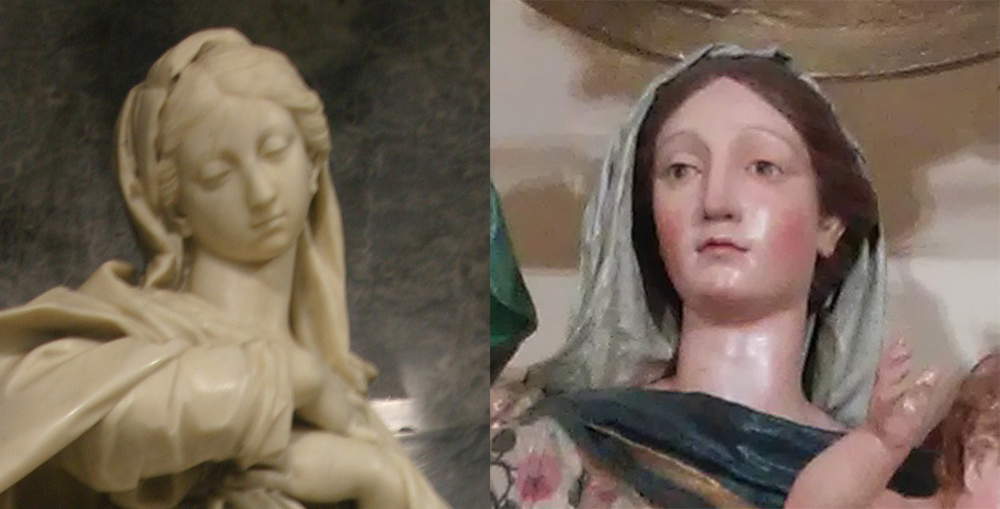 |
| The face of theImmaculata of the Civic Hospital of Carrara (left, photo by Andrea Fusani) and that of the Madonna del Rosario |
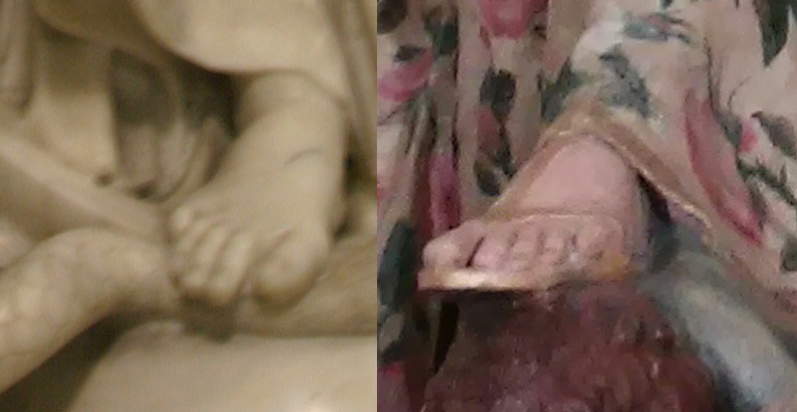 |
| Foot of theImmaculata (left, photo by Andrea Fusani) and foot of the Madonna of the Rosary. |
After the restoration was completed, the Madonna of the Ros ary was placed behind the 17th-century marble altar in the Baptistery of Carrara Cathedral. The problem is that such placement inevitably sacrifices the sculpture. For it is a work designed to be appreciated from the back as well: its current arrangement makes only frontal observation possible. Of course: we also tremble at the thought, conjured up by some in town, that the work could immediately return to being carried in procession: it has just undergone a long and delicate restoration, let’s leave it alone at least for a while. But it would be good if we could discuss a location that would do justice to a valuable work (also as the only processional machine and the only papier-mâché work by Giovanni Antonio Cybei, as far as we know) and that would allow the public to admire it in the most congenial way possible.
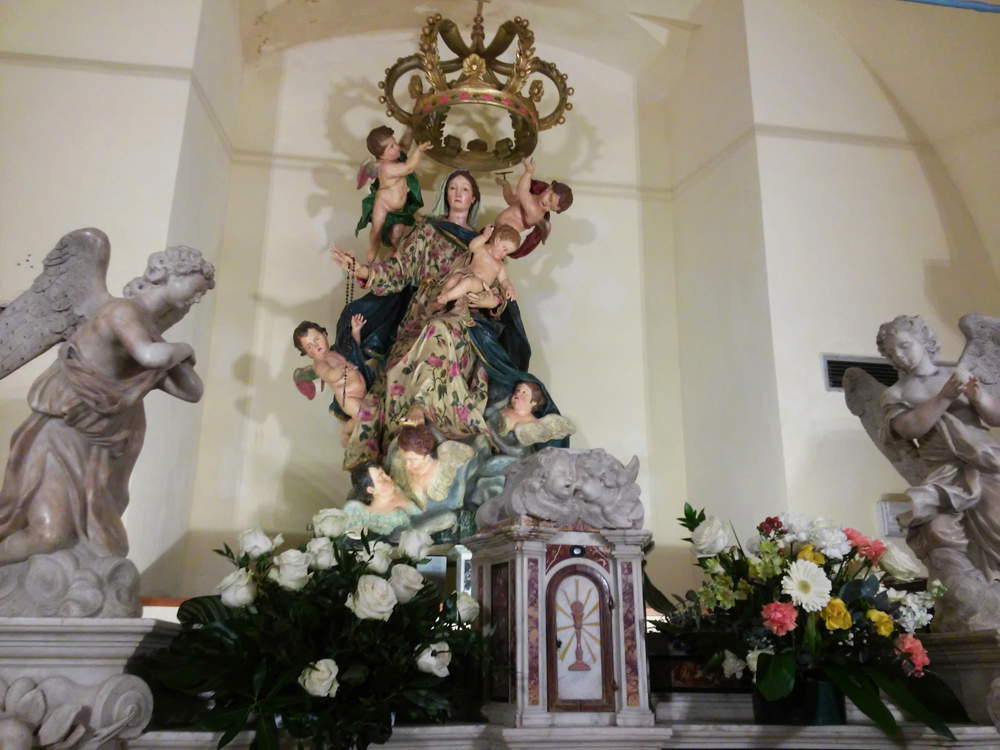 |
| Our Lady of the Rosary behind the altar angels. |
Reference bibliography
- Andrea Fusani, The great “ machine ” of the Virgin of the Rosary by Giovanni Antonio Cybei, 2017(download)
- Andrea Fusani, Dal Choro alla Bottega. New acquisitions on Giovanni Antonio Cybei in Commentari dArte, 14, Year V, 1999 (2003), pp. 37-48
- Stella Rudolph, LAbate Giovanni Antonio Cybei: first director of the Accademia Carrarese and statuary for the courts of St. Petersburg, Massa and Modena, in Pittura Toscana e Pittura Europea nel Secolo dei Lumi, SPES, 1993, pp. 99-118
Warning: the translation into English of the original Italian article was created using automatic tools. We undertake to review all articles, but we do not guarantee the total absence of inaccuracies in the translation due to the program. You can find the original by clicking on the ITA button. If you find any mistake,please contact us.





























